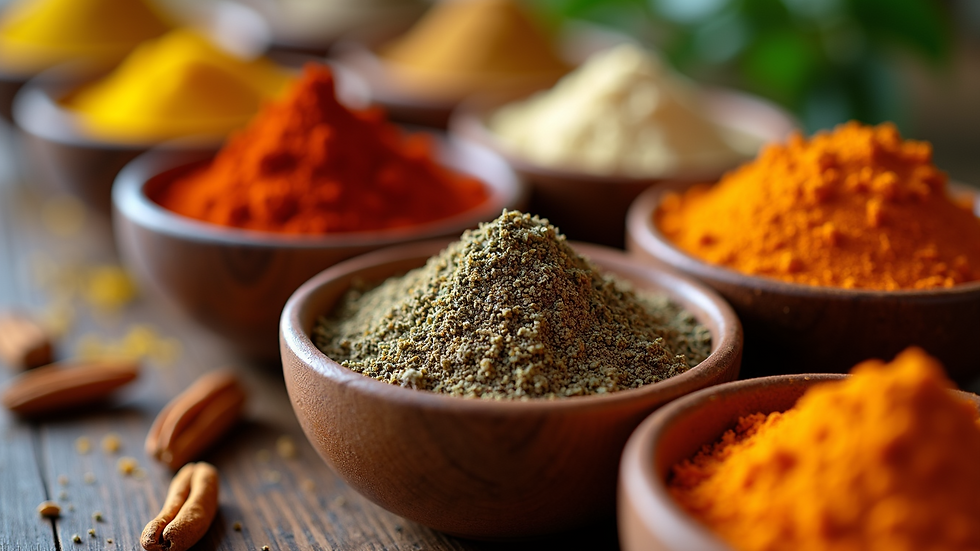How to Choose the Perfect Rub for Your Meat
- Reweti Montgomery
- Aug 11
- 3 min read
Choosing the right meat rub can transform your cooking and elevate the flavour of your meat to new heights. Whether you are grilling, smoking, or roasting, a well-chosen rub adds depth, texture, and a burst of taste that complements the natural juices of the meat. This guide will help you understand how to select the perfect rub for your meat, ensuring every bite is delicious and memorable.
Understanding Different Types of Meat Rubs
Meat rubs come in many varieties, each designed to enhance specific types of meat or cooking styles. Generally, rubs are a blend of herbs, spices, salt, and sugar that create a crust or bark on the meat when cooked. Here are some common types:
Dry Rubs: These are mixtures of dry spices and herbs. They are easy to apply and perfect for grilling or smoking. Examples include paprika, garlic powder, black pepper, and brown sugar.
Wet Rubs: These include oils or liquids like mustard or vinegar mixed with spices. They help the rub stick better and can add moisture.
Regional Rubs: Different regions have signature rubs, such as Cajun rubs with cayenne and thyme or Texas-style rubs heavy on black pepper and salt.
When choosing a rub, consider the type of meat you are cooking. For example, pork pairs well with sweet and smoky rubs, while beef often benefits from bold, peppery blends.

Close-up view of assorted spices in bowls for meat rubs
How to Match Meat Rubs with Meat Cuts
Selecting the right rub depends on the cut and type of meat. Here are some practical tips:
Beef: For steaks and brisket, use rubs with coarse black pepper, garlic, and salt. These enhance the beef’s natural flavour without overpowering it.
Pork: Sweet and spicy rubs with brown sugar, paprika, and chili powder work well on pork ribs and shoulders.
Chicken: Use lighter rubs with herbs like thyme, rosemary, and lemon zest to complement the delicate flavour.
Lamb: Earthy rubs with cumin, coriander, and mint add a Mediterranean touch.
Apply the rub generously and massage it into the meat. Let it rest for at least 30 minutes or overnight in the fridge for deeper flavour penetration.

Eye-level view of raw meat with spice rub applied on a wooden board
What is the difference between rubs and marinades?
Understanding the difference between rubs and marinades is key to choosing the right flavouring method for your meat.
Rubs are dry or wet mixtures applied directly to the surface of the meat. They create a crust or bark when cooked, locking in juices and adding texture.
Marinades are liquid mixtures that soak the meat for hours or overnight. They tenderise the meat and infuse it with flavour throughout.
Rubs are quicker and easier to use, perfect for last-minute cooking. Marinades require more time but can deeply flavour tougher cuts. Sometimes, combining both methods yields the best results.

High angle view of a bowl with marinade and spices next to raw meat
Tips for Buying Quality Meat Rubs
When purchasing meat rubs, keep these tips in mind:
Check the Ingredients - Look for natural spices and avoid artificial additives or preservatives.
Consider the Salt Content - Some rubs are very salty, which can affect the cooking process.
Choose Based on Cooking Method - Some rubs are better for smoking, others for grilling or roasting.
Try Small Quantities First - Experiment with small amounts to find your favourite flavour profile.
Look for Trusted Brands - Brands like meatheads rubs offer high-quality blends crafted for New Zealand tastes.
Using a quality rub can make a big difference in your cooking experience and the final taste of your meat.
Enhancing Your Cooking with Meat Rubs
To get the most out of your meat rubs, follow these practical recommendations:
Apply Rubs Evenly: Use your hands to spread the rub evenly over the entire surface of the meat.
Let it Rest: Allow the meat to rest with the rub for at least 30 minutes before cooking. For tougher cuts, overnight resting in the fridge is ideal.
Adjust Cooking Times: Rubs with sugar can caramelise quickly, so monitor cooking times to avoid burning.
Pair with Complementary Sauces: After cooking, serve with sauces that complement the rub’s flavour, such as BBQ sauce for smoky rubs or chimichurri for herb-based rubs.
Experimenting with different rubs and techniques will help you discover your perfect flavour combination.
Choosing the perfect meat rub is an art that combines knowledge, experimentation, and a love for good food. By understanding the types of rubs, matching them to your meat, and using quality products like meatheads rubs, you can create mouth-watering dishes that impress every time. Happy cooking!



Comments